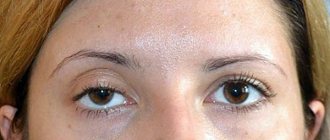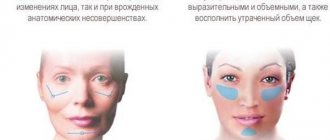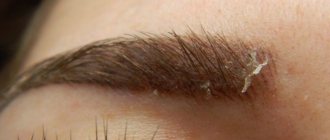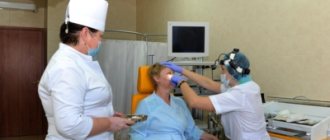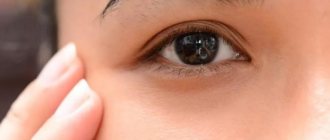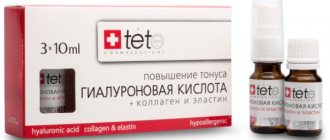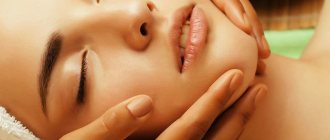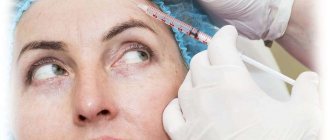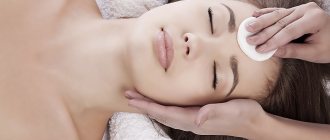| An expressive look has always been the key to attractiveness. But expressiveness is expressed not only in the depth of eye color and the volume of eyelashes. The shape and position of the eyebrows radically change the face. Low eyebrows create the feeling that the person is gloomy and dissatisfied. Drooping outer eyebrows give the appearance of fatigue. Agree, all this does not arouse the sympathy of others, but rather the opposite. In addition, naturally low-set eyebrows will hang over the eyes due to age-related changes. However, it is enough to tighten your eyebrows to make your look more open, and your face younger and happier. Eyebrow lifting is a great solution to get rid of a dull, tired look. | Useful links:
|
What is eyebrow lifting with threads?
Brow lifting with threads is performed to remove cosmetic defects associated with age-related skin changes. The procedure can be performed under general or local anesthesia, it all depends on the type of threads used and the individual characteristics of the patient’s body.
Threads biocompatible with the human body are implanted under the skin, which are securely fixed in the soft tissues, providing a pronounced effect of lifting the eyebrow arches and smoothing out deep wrinkles in the forehead and between the eyebrows. The effect of the procedure is noticeable almost immediately: the patient gets rid of a heavy, tired look, and the face looks more fresh, rested, and rejuvenated. Eyebrow lifting with threads is performed at the age of 35–40 years, when the signs of gravitational ptosis are noticeably expressed.
After the procedure, facial expressions in the area of the eyebrows and forehead remain natural. The technique does not require long-term rehabilitation, and if the implantation technology is strictly followed, it practically does not cause side effects. For eyebrow lifting, cosmetologists at the International Hemostasis Clinic use the most modern, safe, well-proven threads, which allow you to achieve the desired effect by postponing radical surgical intervention.
Threadlifting Mesothreads with multi-directional notches 1 piece 3,300 rub. Consultation with a cosmetologist, subject to the provision of the service on the day of consultation 0 rub.
All prices Make an appointment
How to do face threading
The procedure for facial hair removal with thread is no different in technology from that described above for treating the upper lip. It is necessary to carefully study the characteristics of the growth of vellus hairs, determine the direction of their growth and work strictly against this direction. To do this, you can additionally apply talc or baby powder to the skin - this will help make the hairs more visible on the face.
However, there are several questions regarding the need for this procedure in principle:
- We need vellus hairs in order to protect the skin from adverse environmental influences, as well as normal thermoregulation;
- after removing vellus hairs, they quickly begin to grow back, they look strange on the face, they can even prick; however, for their subsequent removal, it is necessary to wait until they grow back to a certain length so that the thread is able to capture and pull out the hairs.
Therefore, if the client’s fuzz on her face is weakly expressed and has no pigmentation, before carrying out the procedure, clarify whether she really wants to perform the hair removal procedure, explain what consequences await her.
Indications for use
The procedure is used by patients aged 35–50 years, when the first signs of age-related changes are already noticeable on the face, but they are well subject to correction using minimally invasive, gentle cosmetological techniques. The technique helps restore the natural lines of the eyebrow arches and get rid of drooping eyelids, which make the look tired and gloomy.
List of indications for eyebrow thread lifting:
- drooping corners of the eyebrow arches and their asymmetry;
- gravitational ptosis of soft tissues;
- deep creases in the forehead;
- drooping eyelids;
- tired, heavy look;
- changing the lines of the oval.
Photos before and after operations
For many ladies, the main life principle is that until I see it with my own eyes, I won’t believe it. We will try to convince our readers of the effectiveness of the procedures, and we invite you to look at photos of eyebrow lifting. This will not only help make sure that the technique really effectively gets rid of defects, but will also prove that modern cosmetology is capable of a real miracle - restoring youth.
You should not wait until the defects on your face are so obvious that even tons of cosmetics cannot hide them. Eyebrow lifting is a technique that will help you forget for a long time that youth is not eternal and will allow you to enjoy the blooming appearance of your face in the mirror. After simple and short manipulations by the surgeon, wrinkles will become a thing of the past and will become only unpleasant memories.
Types of threads
To correct eyebrow arches and get rid of gravitational ptosis, different types of threads are used, which differ in chemical composition, method of fastening, and model features. Thread fibers are:
- Non-absorbable. Mainly used to correct age-related changes in patients over 50 years of age. They are high-density threads that do not dissolve over time and are securely fixed in the deep layers of soft tissue, providing a pronounced long-term lifting effect.
- Biodegradable. These threads have a validity period, since after a certain time they dissolve and are eliminated from the body on their own. The fibers are implanted in the upper layers of the epidermis. A strong collagen framework is formed around them, which continues to have a pronounced lifting effect for several years. Biodegradable threads are used for patients over the age of 40 and are an excellent preventive measure against withering and gravitational ptosis of soft tissues.
- Liquid. They are a gel-like composition that contains hyaluronic acid. After subcutaneous implantation, the mass hardens, forming a reliable frame. Liquid threads are eliminated from the body on their own within 2.5 – 3 years.
Smooth
This type of thread is made from such non-absorbable materials as:
- silicone;
- polyimide;
- polyurethane.
Smooth fibers are introduced through incisions up to 5 mm long and fixed using special knots that will be located under the skin. This type of thread allows you to achieve a pronounced lifting effect even with significant age-related changes, so they are mainly prescribed to patients over the age of 50 years. The rejuvenation result lasts for an average of 4.5 – 5 years.
Mesothreads
They are a biodegradable material that self-resolves and is eliminated from the body within six months. During this time, a reliable collagen frame is formed around the mesothreads, which provides a pronounced lifting effect for 2 – 2.5 years.
Mesothreads are inserted subcutaneously using a special needle that does not injure soft tissues, so the procedure is considered minimally invasive and safe. The technique is prescribed to patients aged 30–45 years, when the first signs of aging and sagging of soft tissues in the forehead, between the eyebrows, and brow arches have just begun to appear.
Combined
Combined threads are made from the following materials:
- propylene;
- lactic acid copolymers;
- glycolide
The material is fixed in soft tissues using knots located along the entire length of the thread. Over time, the nodules dissolve on their own, and in their place remains a framework of connective tissues, providing reliable reinforcement, rejuvenation and tightening of the skin. The results of lifting with combined fibers last for 5 – 7 years.
Gold
Gold thread is a thin wire with a diameter of less than 0.1 mm. The choice of this type of precious metal for making threads is not accidental. Gold does not cause allergic reactions, is not aggressive towards tissues, stimulates microcirculation, providing high-quality nutrition and oxygen supply at the intracellular level.
Gold threads do not dissolve over time. Within 6–8 months after implantation, a collagen framework is formed around each thread, which provides reliable reinforcement of soft tissues. The main disadvantage of gold eyebrow lifting is the inability to resort to cosmetic hardware procedures in the future.
Service cost
The cheapest linear threads made of polydioxanone, price - from 700 rubles per piece. Needle-shaped ones with notches cost from 1,500 rubles. A facelift will cost 20,000-35,000 rubles.
Mesothreads made from a copolymer of L-lactide with caprolactone and polylactic acid are significantly more expensive (unit price including labor and anesthesia):
- Aptos Nano Vitis-4 from RUB 1,500;
- Screw and Double Screw from PDO – from 1500 rub.
- Silhouette Lift - 15,000-20,000 rubles.
The average price for a gold thread lift is:
- cheeks – 50,000 rubles;
- nasolabial triangle – 35,000 rubles;
- upper part of the face – from 40,000 rubles.
Preparation for the event
Since eyebrow thread lifting is carried out according to medical indications, a consultation with a specialist is first necessary. The doctor will conduct an initial examination, assess the general condition of the skin, explain how the procedure is carried out and how many threads will be required, and also calculate the cost of the procedure.
The technique has a number of contraindications, ignoring which is fraught with negative consequences. To exclude or confirm restrictions, the doctor will give a referral for a diagnostic examination, the results of which will help assess the patient’s health status and identify hidden diseases. If everything is in order with your health, the cosmetologist will agree on the date and time of the lifting, and also give advice regarding preparation. In 7 – 10 days you need:
- give up alcohol and intense physical activity;
- exclude from the diet spicy, salty, fatty foods that contribute to the formation of edema;
- refuse to visit the bathhouse, sauna, solarium, hot tubs;
- stop taking medications that affect blood viscosity.
It is not recommended to smoke on the day of the procedure because nicotine affects blood viscosity. These preparation rules will help avoid post-procedure complications such as:
- swelling;
- hematomas;
- unevenness of the lift.
Complications
Unlike temporary phenomena, complications do not go away on their own. In most cases, they require medical intervention and often lead to the removal of the threads. All of them are divided into complications of a general nature (characteristic of all minimally invasive techniques) and specific to thread lifting.
According to statistics, most of these complications are associated with violations of the thread implantation technique: non-compliance with the rules of asepsis and antisepsis, the choice of installation trajectories that do not correspond to the vectors of movement of the facial muscles, the choice of material or configuration of threads that are not suitable for tightening soft tissues in a given area.
The division of threads into surgical (non-absorbable) and cosmetic (absorbable) is quite arbitrary and has virtually no effect on the nature of complications.
Allergic reactions
They cannot be excluded when carrying out any aesthetic procedure. During thread lifting, an allergic reaction can be caused by an anesthetic or a skin treatment product. It is extremely rare that the body reacts to the material itself - after all, only time-tested suture materials are used to make threads.
What to do: If an allergic reaction is caused by an anesthetic or a treatment agent and is expressed in redness and itching of the skin, antihistamines can help cope with the situation. However, there are also emergency conditions - for example, anaphylactic shock. It requires, firstly, the immediate use of drugs, which must be in every treatment room (most often, prednisolone, adrenaline, suprastin, aminophylline). Secondly, it is necessary to urgently call an ambulance team.
If an allergic reaction occurs on the threads (most often, if they are made from counterfeit low-quality material, and it is this material that is to blame for the allergic reaction), they must be removed. This allergic reaction usually occurs delayed.
Infectious-inflammatory reaction
This is perhaps the most common complication and is primarily due to the fact that thread lifts are taken rather lightly. They forget that the thread is an implant, and the doctor should approach the procedure as a minor operation (carefully prepare the room, instruments, consumables). Most complications can be avoided by following preventive measures: it is important not to be lazy in collecting anamnesis, properly preparing the patient for the procedure, washing hands correctly, performing the procedure only in a specially equipped room, etc.
What to do: In most cases, antibiotics help to cope with the infection in the initial stages. In severe situations - with extensive abscesses - the thread must be removed.
Unlike aesthetic surgeries, minimally invasive procedures do not require a single prior dose of antibacterial agents as prophylaxis.
Inflammation that occurs a few days after insertion of the thread
Violation of facial expressions
This complication is due to the fact that some manufacturers in their recommendations, and following them doctors, do not take into account such an important thing as facial biomechanics. There are certain vectors of movement of facial muscles. If you do not take them into account when placing the threads, facial expressions and features will be distorted.
Impaired facial expressions may be caused by damage or compression of motor nerves. However, such cases are extremely rare! Most thread lift techniques involve implanting threads into the subcutaneous fatty tissue, which, if the recommended trajectories are followed, virtually eliminates nerve damage.
What to do: if there is a clear violation of facial expressions, the threads must be removed.
Persistent contour violation
It is very important not to confuse this complication with the effect of overcorrection, which we already discussed above. Most lifting threads today have a fixation system (notches, cones, knots, etc.). If you apply significant force when fixing the fabric to the thread, you can get a pronounced “overtightening” effect (persistent deformation of the contour).
What to do: Sometimes a simple facial massage helps to return the tissues to the desired position. It gives a good effect with the linear technique of installing threads. When installing threads in the form of a loop, massage, unfortunately, is ineffective. Therefore, with this technique, overcorrection should be minimal. In severe cases, the threads have to be removed.
Thread migration
This complication is typical for smooth threads without a fixation system. By the way, these include the smooth mesothreads . “When a smooth monofilament thread is inserted into the subcutaneous fat, it is able to pass through it like a needle through oil and, ultimately, move away from the starting point of installation,” explains Igor Gulyaev. “For example, patients came to us in whom, ten years after installation, the gold threads in the chin area became “in a ball” and had to be pulled out.”
What to do: This situation, of course, requires the removal of threads. The tip of the thread can rest against the skin and contour. And sometimes the thread can even perforate (pierce) the skin. According to our expert, the thread must have a fixation system - no matter what it will be (notches, cones or something else).
Smooth monofilament from a well-known manufacturer
Thread contouring
The appearance (outlining) of threads under the skin is most often the result of improper installation technique. For example, they were introduced too superficially or unevenly. Each type of thread has its own layer, which must be strictly observed. Most often this is subcutaneous fatty tissue, sometimes it is the dermis; some techniques involve the installation of threads even in SMAS.
What to do: The thread has to be removed. In some cases, a separate fragment is deleted, in others, the entire thread is deleted.
Skin retraction at the injection and puncture sites
“Dimples” where the needle enters and exits were once quite common. Today, the development of paired needles that form a single point helps to avoid their appearance at the injection point. With their help, you can immediately get to the desired depth. Retraction at the puncture site usually occurs if the notch is too close to the surface and partially “picks up” the dermis. To even out the skin, just lightly massage the puncture point.
What to do: If the retraction at the injection point is persistent and does not disappear within 3-4 weeks, you can slightly separate (peel off) the skin at the site of retraction under local anesthesia. In most cases this is enough.
How does the procedure work?
Eyebrow lifting with threads is carried out in a cosmetology clinic by a specially trained cosmetologist, who, upon the client’s request, is required to provide a license confirming his qualifications. Only high-quality, certified material should be used for the procedure. The package of threads is opened in the presence of the patient. It is prohibited to perform lifting with threads that were stored in damaged or pre-opened packaging.
The thread lifting technique includes the following steps:
- Immediately before the procedure, the cosmetologist photographs the client in five projections, which will allow the lifting effect to be assessed later.
- The cosmetologist cleanses the facial skin of decorative cosmetics and other contaminants.
- To prevent infection and inflammation, the skin is thoroughly treated with an antiseptic solution.
- Thread insertion points are marked with a marker. Implantation can be carried out perpendicularly or parallel to the eyebrow arches.
- Next, the doctor injects an anesthetic that acts exclusively on the target area.
- As soon as the anesthesia takes effect, the cosmetologist, using a special ultra-thin needle or cannula, makes a micro-puncture, implanting threads to a certain depth.
- The fibers are carefully stretched and fixed in soft tissues using special knots that will be located under the skin. To correct the eyebrows, between the eyebrows, and the forehead area, 10–20 units of material are usually used.
- After fixation, the needles are removed, and their insertion sites are additionally treated with an antiseptic.
- To soothe irritated skin and prevent the formation of swelling, hematomas, a cold compress is applied to the puncture site.
The duration of the procedure is 30 – 60 minutes. After implantation, the patient can return home, where rehabilitation will take place.
On what areas of the skin can threads be used?
Thread threading can be used in absolutely any area of the body where sufficient skin tension is provided. That is, on the armpits, where the skin often gathers into wrinkles, such a procedure is very rarely performed, since there is a risk of catching a small fold and pinching it with a thread. Mostly threading is performed on the face, but there are also masters who work with thread on the legs, arms and even in the bikini area. This is not always advisable, since the hairs vary in structure and length, and the thread cannot always grasp them firmly. In addition, the surface to work on is large enough, so it will be faster and easier to use wax or sugar paste on these areas.
But in the head area, hair removal with thread is quite effective and advisable. Most often, craftsmen work with the following areas:
- eyebrows - if there are too many extra hairs, the thread allows you to remove them faster than tweezers, and the accuracy of the work does not suffer; if very short hairs have not been removed, they can already be removed with tweezers;
- hairline – if there is too much “undercoat” growing on the forehead and sides of the face, you can quickly and permanently get rid of it using a special thread;
- neck – the same excess “undercoat” hairs are quickly and effectively removed during the threading procedure;
- cheeks, cheekbones, chin, forehead and other places where vellus hairs grow;
- the area above the lip - it doesn’t matter whether darker and longer vellus hairs or thicker hairs grow there.
Healing period
The duration of the rehabilitation period depends on the type of threads used and the individual characteristics of the patient’s body. On average, recovery takes 1 – 3 weeks. During this time, post-procedure symptoms completely disappear and the patient can evaluate the first results of the lifting.
During the rehabilitation period, it is important to strictly follow the recommendations of the cosmetologist:
- In the first 2 - 3 days, do not touch your face with your hands, refuse decorative cosmetics.
- Treat the skin with an antiseptic solution 3 times a day until the micro-wounds are completely healed.
- Limit active facial expressions for 5–7 days.
- You are allowed to sleep only on your back, with a high pillow under your head.
- During the entire rehabilitation period, do not visit the swimming pool, solarium, sauna, or bathhouse.
- Avoid eating salty and spicy foods that contribute to the formation of swelling.
What effect should you expect?
Cosmetologists claim that after the procedure, horizontal furrows on the forehead are smoothed, “crow’s feet” and ptosis of the upper eyelid are eliminated. The eyebrow line is tightened, the gaze becomes more open.
The first results are noticeable initially, but the final results are only after 3-4 months, because all this time the frame is being formed.
Regarding the duration of the effect, it depends on what type of threads were used for the procedure and ranges from 2 (for mesothreads) to 7 years (Silhouette Lift).
Before and after
Contraindications
Despite the fact that eyebrow thread lifting is considered a safe, minimally invasive procedure, it still has contraindications:
- pregnancy, breastfeeding;
- chronic dermatological diseases in the acute stage;
- oncology;
- diseases of the hematopoietic system;
- the need for constant use of drugs that affect blood viscosity;
- hormonal, endocrine disorders;
- decompensated diabetes mellitus;
- autoimmune disorders;
- congenital or acquired immunodeficiency;
- cardiovascular pathologies;
- renal, liver, pulmonary failure;
- somatic and mental disorders;
- tendency to form keloid or hypertrophic scars;
- individual intolerance to the components of the material.
Non-surgical effect
The results obtained through non-surgical treatment are minimal. Here the procedures are based on enhancing collagen synthesis. They are often used to protect against moderate ptosis of the forehead and to raise the eyebrows.
List of procedures:
- biorevitalization - performed in the form of injections of hyaluronic acid to restore water balance, helps to moisturize the skin, slow down its age-related aging;
- mesotherapy – carried out in the form of injections of a multicomponent composition, provides nutrition, hydration, increased immunity, improved tone of the skin area;
- Botox - injections of botulinum toxin A, aimed at combating wrinkles, folds, moderate ptosis, the result is achieved by temporarily paralyzing the muscles responsible for contracting the skin on the forehead;
- hardware massages - usually performed using ultrasound or vacuum, aimed at increasing blood circulation, lymph flow, increasing the supply of cells with oxygen and other necessary substances, allowing to optimize internal processes, accelerate collagen production, and increase external elasticity;
- light exposure - the emitted light will be absorbed by the skin and transformed into heat, leading to an increase in collagen synthesis;
- radio wave exposure (thermage) - eyebrow lifting is performed through radio wave radiation, safe for humans, penetrating soft tissues without destroying them in order to tighten collagen fibers and create the effect of tightened skin.
Most popular: What is the difference between cosmetics in ampoules and classic ones?
One session for 1-4 procedures costs approximately 2 thousand rubles, and for 5-6 - 4-6 thousand rubles. They are performed in a course of several sessions.
The procedures have a short recovery time and minimal problems. However, they give a weak effect and do not allow one to get rid of severe forehead ptosis. However, there are contraindications. Thus, hardware massages cannot be performed if there are built-in pacemakers.
Advantages and disadvantages
Eyebrow lifting with threads has many advantages compared to other minimally invasive cosmetic procedures:
- The fibers used for implantation are made from materials biocompatible with the human body, so the risk of allergies and side effects is minimized.
- The punctures through which the threads are inserted are microscopic, so after they heal, no scars, scars or other defects remain on the skin.
- After lifting, no long rehabilitation is required. The recovery rules are simple and accessible, do not cause discomfort or difficulty in compliance.
- The effect after the procedure lasts for several years.
- The technique is suitable for all skin types.
- After the manipulations, a doctor’s supervision is not required; you can go home straight away.
But the procedure has its drawbacks, which are important to familiarize yourself with before resorting to it. Main disadvantages:
- there is always a risk of side effects;
- the procedure does not affect the general condition of the skin;
- ineffective after 50 years;
- discomfort and pain are possible during manipulation;
- a large list of contraindications.
Advantages and disadvantages of the technique
| pros | Minuses |
|
|
Cost of eyebrow thread lifting
In Moscow, the eyebrow thread lifting procedure will cost 100,000 rubles. It all depends on the materials used, the size of the treatment area, and the degree of neglect of the problem.
To clarify prices and make an appointment with a cosmetologist at the International Hemostasis Clinic, call the number or use the feedback form so that our administrators can contact you and answer all your questions.
Threadlifting with threads
Facial skin tightening with 3D mesothreads
How to do eyebrow threading
Threading is a technology that is used not only by hair removal specialists, but also by eyebrow specialists. Using a thread, you can carry out effective and high-quality correction or eyebrow architecture, since threading allows you to quickly and accurately remove unwanted hairs without causing major trauma to the skin.
The procedure is especially in demand among owners of lush, thick and wide eyebrows with a large number of separately growing hairs. If the correction does not require removing a lot of excess bristles, the technician can do it faster with ordinary tweezers.
The method of threading a face with thread is not particularly difficult, and anyone can learn this technique. However, the accuracy, speed and accuracy of the work directly depend on experience and dexterity, plus it is always easier to perform the procedure on someone else than on yourself. In addition, with insufficient experience, you may not pull out the hairs, but break them off, which will subsequently lead to ingrown hairs. Therefore, it is better to turn to professionals for services, which is what you must convince your clients of.
It is also important to use high-quality and reliable materials and tools in your work, which you can buy in our online store. In our catalog, special threads for threading are available in a large assortment and at reasonable prices.
You will find all the necessary materials for the work of an eyebrow master in our store. Buy and work successfully and with pleasure!
First and second generation of APTOS threads
More than 20 years have passed since the invention of the first generation of Aptos threads - the method has gone through a long path of formation and development, from invention to implementation in practice, obtaining results and monitoring them for many years.
The knowledge and experience accumulated over the years has allowed the APTOS company to further improve the methods of thread lifting - thus, a certain “ideal formula” has appeared at the disposal of aesthetic medicine.
The second generation of threads was so popular among inventors and aestheticians around the world that the first generation was gradually completely forgotten - since the second generation was simpler, gave better results, fewer nuances and complications. This was truly a significant step forward.
The development of the second generation of threads proceeded at a rapid pace - the production of threads for various purposes began. Some of them were intended for both plastic surgeons and dermato-cosmetologists.
In 2012, the APTOS company introduced the world to even more modern threads - Aptos Excellence Visage - they are used all over the world and there is no analogue of this product in the world today.
These threads do not require specific installation; no complex turns with a needle under the skin, knots, etc. are required. It is very simple to perform and gives excellent results - such as with a surgical lift. This method is still popular today, but manufacturers did not stop there and at a new stage of development began to use smaller, shorter and thinner threads.
Temporal brow lift
@dr.komnatov
There are some differences between performing an endoscopic forehead and eyebrow lift and a temporal brow lift. The operation can be performed under local or general anesthesia. The method is determined by the doctor taking into account the procedure. On average, a lift takes about ¾ hour.
The eyebrow correction method is based on making incisions in the temple area and removing excess skin. The technique allows you to get rid of wrinkles, lift the corners of the eyes, and tighten the cheekbones. This type of correction can be combined with other plastic surgeries. Forehead correction with threads is highly effective.
@dr.komnatov
Indications for implementation are loss of skin elasticity, appearance of wrinkles and folds. Due to lifting, the lateral, diagonal part of the upper third of the face is corrected. Plastic surgery corrects the temporal zone, arches, and forehead. The operation allows you to make your gaze more open and partially remove drooping eyelids.
The advantages of this lifting are that the facial contour is preserved, the mobility of facial muscles is not impaired, and if performed correctly, the scars are invisible. In total, two types of such correction are provided. The option is selected based on the type of access to the adjustment zone:
- The open version is used for large excess skin.
- The endoscopic option is considered virtually non-invasive.
There are contraindications for performing the manipulation. These are chronic heart pathologies, diabetes mellitus, low blood clotting, eye diseases, thyroid diseases, and oncology.
Some time before the operation you need to quit or limit smoking and limit alcoholic drinks. If you are taking medications regularly, you should consult your doctor in advance. It is recommended to reduce the amount of spicy, fried foods you consume.
APTOS threads are a global brand
APTOS threads are a global brand in aesthetic medicine. New methods allow certified doctors around the world to help patients maintain youthful, elastic and hydrated skin.
Over these many years, dozens of analogues in the field of thread lifting have been created in the world, but Aptos to this day holds a leading position due to its high quality and variety of products.
APTOS doctors regularly share their experience with dermatocosmetologists and plastic surgeons around the world, meeting at master classes and scientific conferences.
The success of the company is evidenced by many certificates and awards received at international conferences. In 2015, 2021 and 2017 Aptos received the so-called Oscar for aesthetic medicine. And Aptos is ISO certified. In addition, this is the first company in Georgia to be awarded the CE mark, which allows it to sell lifting threads in European countries. Aptos is registered in almost 50 countries around the world. The company constantly cares about the comfort and safety of its consumers. Therefore, only certified surgeons and dermato-cosmetologists can use Aptos threads.
Causes of drooping eyebrows
Omission occurs for various reasons:
- The aging process leads to the need to lift sagging curves.
- Gravitational changes in tissues and atrophy.
- High level of elasticity of connective tissues.
- Negative environmental influences (excessive amounts of ultraviolet rays, air pollution).
- Trauma to the frontal zone on the facial nerve.
The problem of drooping eyebrows is relevant for older people. Their shape changes, bringing dissatisfaction with their appearance.
It is important to begin correcting the location and raising the bends in the early stages of the deformity.
An integrated approach and consultation with a cosmetologist will help to identify the cause of the problem and outline a plan for restoring facial proportions.
